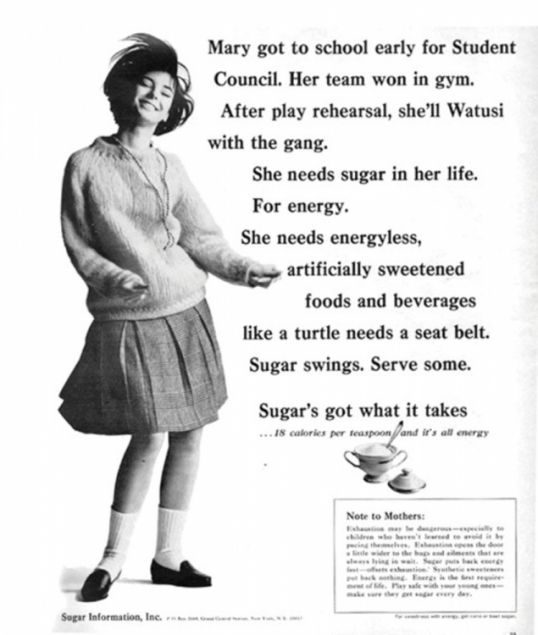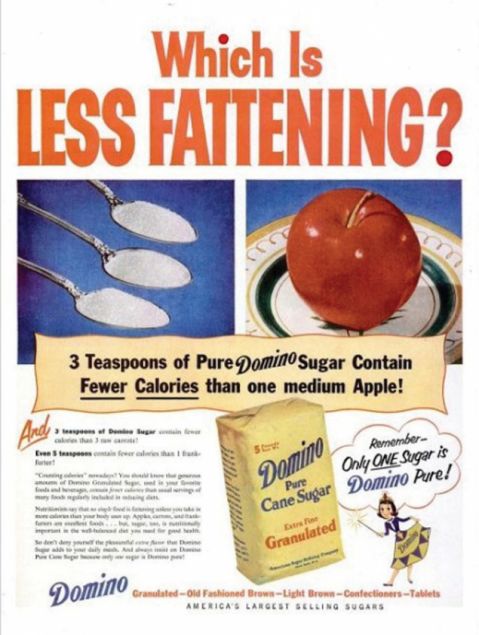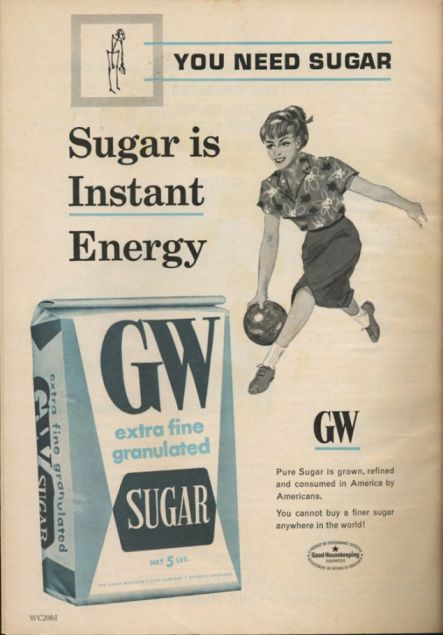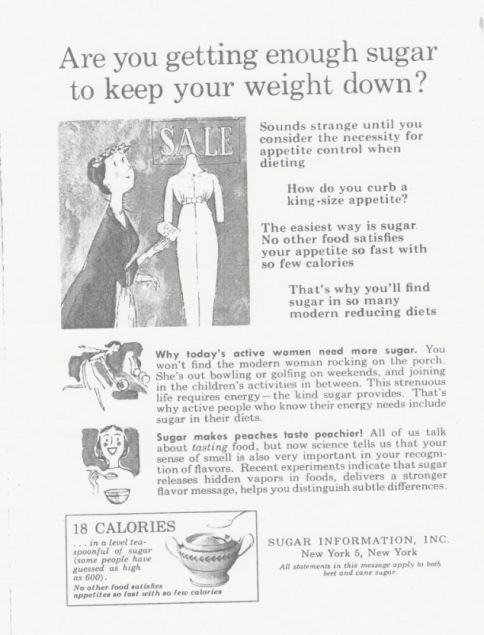The missing link for a stack of folk out there when I bang on about how bad sugar (or, more specifically, fructose) is for us is this:how it has come to be that a) no one has told us this before and b) in fact, we’ve been told quite the opposite our entire lives.
And not just by the Big Bad Sugar Companies. By the Government and the health advisory bodies, too.
Sigh. It’s a very long and complicated explanation. And, unfortunately, it requires using the word “conspiracy” a fair bit, which turns a lot of us off. If you’re interested in a very thorough rundown of how the sugar industry dupes us and shuts down counter views in the US, check out this MotherJones timeline. It’s fascinating stuff. Much the same happen here in Australia, and around the world. (And, PS, the pictures I’ve used here to break up my rant are from their collection, too. They make an apt backdrop, don’t you think?)
But to news just in, here in Australia. The National Health and Medical Research Council (NHMRC) – Australia’s main health adviser – yesterday published its once-a-decade update of the Australian Dietary Guidelines.
And. Wait for it.
We’re finally being told to “limit” sugar!
This actually represents a toughening of official advice against added sugar, advising Australians for the first time to “limit” our consumption of added sugar, in the same way we have been encouraged to “limit” our consumption of alcohol.
Yes, this is a big deal. Why?
1. Because previously we’ve been told that sugar is OK in moderation.
Yes, the guidelines used to say to moderate sugar consumption. Which is just dumb, and scary and depressing when the evidence points to the fact sugar is highly addictive and we’re designed to binge on it. Moderation is fine for everything else. For most, it’s impossible with sugar.
2. Because the Guidelines survived strong opposition from various pro-sugar forces.
It’s hard to fathom, but a lot of our “health advisers” around the country lobbied against the wording. Yes, the University of Sydney’s highest-profile nutritionists campaigned against advice to limit sugar intake. Devastating, irritating, but true. These are the experts wheeled out by current affairs programs as scientific authority on the matter, over and over, with no disclosure of their interests in the sugar industry. No wonder we’re all confused!
Why would nutritionists do such a thing? Why speak out about it so passionately? And why do these “experts” actively seek out people like me, criticising us for wishing to “limit” our sugar intake? It’s one thing to disagree. But to campaign? That takes a bee under a bonnet. Or…
…an interesting interests in the sugar industry. You can catch up on this issue here. And you can read more about their fixation with showing that Australians are somehow eating less sugar, using sham statistics discontinued as unreliable by the ABS more than a decade ago here.
Amanda Lee, who chaired the NHMRC committee, says the new guidelines are based on thousands of peer-reviewed papers and backs up what I’m saying.
“The challenge is that there’s so many people out there in the community that have got a vested interest in the dietary guidelines,” she said.
“Our job is to make sure that the science is very sound and very robust and to spread the messages based on that science.”
Word.
But it’s not a perfect outcome. How so?
The Guidelines refer to limiting “intake of foods and drinks containing added sugars such as confectionary, sugar-sweetened soft drinks and cordials, fruit drinks, vitamin waters, energy and sports drinks”. The document reads:
Recent evidence indicates that it is probable that consumption of sugar-sweetened drinks (soft drinks) is associated with
increased risk of weight gain in adults and children (Grade B; Evidence Report, Section 15.1), a finding
confirmed by a later longitudinal study…The literature review to inform the revision of the Dietary Guidelines for Americans,
2010 found strong evidence that greater intake of sugar-sweetened drinks is associated with increased
adiposity in children and moderate evidence that consumption of sugar-sweetened drinks is associated with
increased body weight in adults.
My issue: it all very much reads to target beverages
I get this. Soft drink contains vast amounts of sugar (10 teaspoons in a can of Coke), easily consumed in huge quantities (due to being a liquid) and over-consumed by kids. But it doesn’t specifically mention the added sugar in other foods.
I guess I have to ask, if sugar is so bad in soft drink, why’s it OK in CocoPops? And BBQ sauce?
Afterall, it all adds up. If large amounts of sugar are bad, why not acknowledge the cumulative consumption of sugar from all food over a day is a problem?
My other issue: it specifies “added sugar”
I don’t get this. Why just added sugar? Does it matter whether its added or just comes in a product anyway? Apple juice contains just as much sugar as soft drink.
If 10tsp of sugar in a glass of Coke is bad, why isn’t 10tsp in a glass of apple juice bad?
The Heart Foundation has done the same – launched a campaign against soft drink. Soft drink is an easy target. And me thinks it allows them to dodge the bullet that is their own funding sources (Kelloggs et al). At least for a little longer.
I should also mention….
The Guidelines advise against all that Low GI guff, which is what the University of Sydney “experts” are vested in, and which can be used to justify extra sugar consumption (fructose is extremely Low GI, thus Nutella is a Low GI product):
The US review found strong and consistent evidence that glycaemic index and/or glycaemic load are not associated with body weight and that modifying either of these does not lead to greater weight loss or better weight management. There is considerable variability in these indices, depending on inter-and intra-individual factors and the form of food (including the degree of processing, stage of ripeness, cooking andcooling times), which may limit practical application. These factors were not included in the literature review to inform the revision of these Guidelines.
Oh, and the happy fat message!
The Guidelines also move from advising people to stick to low-fat foods. Can you believe it!??
The Heart Foundation waded in on this, saying the old guidelines lead to people thinking they should cut all fats out of their diet. Which is bad for heart health.
Overall, this is what I think:
The shift acknowledges that something has to be done about sugar. It’s highly symbolic. It represents a (baby) step towards steering the corrupt beast that is our dietary guideline set-up towards the truth.
It also sticks it up the various bodies with vested interests who’ve had a stranglehold on what we put on our gobs. This, too, is highly symbolic and significant.
The two messages – eat less sugar and more full fat – go hand in hand. And to this end, what I’m overjoyed about here is that
this shift represents a move toward whole food eating
Eating as our grandparents used to eat, before vested interests intervened. This is huge!
PS You might enjoy this read by a Melbourne professor outlining how the Australian food industry will now try to bring down the NHMRC’s findings.
What do you think?






